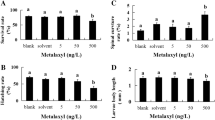Abstract
Exposure to tributyltin (TBT) produces deformities in regenerating limbs of the fiddler crab,Uca pugilator. This study was designed to ascertain whether there was a “sensitive period” during the four-week regeneration time following multiple autotomy, during which TBT exposure was more likely to result in malformations. Groups of crabs underwent autotomy of the chela plus five walking legs, and were exposed to 5.0 or 0.5 μg/L TBT continuously or only during week one, week 2, week 3, or week 4. Regeneration was monitored, and after ecdysis regenerated limbs were examined. The degree of malformation was evaluated on a scale, and for each crab the scores for each of its abnormalities were added together to arrive at an “abnormality index.” While the mean abnormality indices for crabs exposed during week one or week four were quite low, the indices for those exposed during week two were comparable to those of crabs exposed continuously, and those exposed during week three were only slightly lower. This indicates that the sensitive period is during weeks two and three, which is the time of basal growth, when the major events of differentiation and morphogenesis take place. Males were much more susceptible than females, due to the greater sensitivity of their regenerating major chela, compared to the minor chela of females. For both sexes, the regenerating chela was responsible for most of the abnormality index, even though there were five walking legs regenerating also.
Similar content being viewed by others
References
Alzieu C, Heral M (1984) Ecotoxicological effects of organotin compounds on oyster culture. In: Persoone G, Jaspers E, and Claus C. (eds) Ecotoxicological Testing for the Marine Environment, Vol. 1. State Univ of Ghent, Belgium, pp 187–196
Bliss DE (1956) Neurosecretion and the control of growth in a decapod crustacean. In: Wingstrand K (ed) Bertil Hanstrom. Biological papers in honor of his sixty-fifth birthday, November 20, 1956. Zoological Inst, Lund, Sweden. pp 56–75
Bryan GW, Gibbs PE, Hummerstone LG, Burt GR (1986) The decline of the gastropodNucella lapillus around south-west England: Evidence for the effect of tributyltin from antifouling paints. J Mar Biol Assoc UK 66:611–640
Cleary JJ, Stebbing ARD (1987) Organotin in the surface microlayer and subsurface waters of Southwest England. Mar Pollut Bull 18:238–246
Davis A, Barale R, Brun G, Forster R, Gunther T, Hautefeuille H, van der Heijden C, Knapp A, Krowke R, Kuroke T, Loprieno N, Malaveille C, Merker H, Monaco M, Mosesso P, Neubert D, Norppa H, Sorsa M, Vogel E, Voogd C, Umeda M, Bartsch H (1987) Evaluation of the genetic and embryotoxic effects of bis(tri-n-butyltin) oxide (TBTO). Mutat Res 188:65–95
Hodge MH (1958) Some aspects of the regeneration of walking legs in the land crabGecarcinus lateralis. PhD Dissertation, Radcliffe College. 140 pp
Krowke R, Bluth U, Neubert D (1986)In vitro studies on the embryotoxic potential of bis(tri-n-butyltin) oxide in a limb bud organ culture system. Arch Toxicol 58:125–129
Maguire RJ, Tkacz RJ (1985) Degradation of the tri-n-butyltin species in water and sediment from Toronto Harbor (Canada). J Agric Food Chem 33:947–953
Salazar MH (1986) Environmental significance and interpretation of organotin bioassays. In: Organotin Symposium. Proc Oceans 86 Conf Sept. 23–25, 1986, Washington DC. pp 1240–1245
Skinner DM, Graham DE (1972) Loss of limbs as a stimulus to ecdysis in Brachyura (true crabs). Biol Bull 143:222–233
Waldock MJ, Thain J (1983) Shell thickening inCrassostrea gigas: Organotin antifouling or sediment-induced? Mar Poll Bull 14:411–415
Walsh GE, Louie MK, McLaughlin LL, Lores EM (1986a) Lugworm (Arenicola cristata) larvae in toxicity tests: Survival and development when exposed to organotins. Environ Toxicol Chem 5: 749–754
Walsh GE, McLaughlin L, Louie M, Deans C, Lores E (1986b) Inhibition of arm regeneration inOphioderma brevispina (Echinodermata, Ophiuroidea) by tributyltin oxide and triphenyltin oxide. Ecotoxicol Environ Safety 12:95–1
Watanabe I (1980) Organotins. In: Spencer S and Schaumburg HH (eds) Experimental and Clinical Neurotoxicology. Williams and Wilkins, Baltimore Md. pp 545–557
Weis JS (1976) Effects of mercury, cadmium, and lead salts on regeneration and ecdysis in the fiddler crab,Uca pugilator. Fish Bull 74:464–467
— (1977) Limb regeneration in fiddler crabs: Species differences and effects of methylmercury. Biol Bull 152:263–274
Weis JS, Donnellon N, Barnwell F (1986) Regeneration of tubercles on limbs ofUca pugilator and effects of mercury and cadmium on their growth. J Crust Biol 6:648–651
Weis JS, Gottlieb J and Kwiatkowski J (1987) Tributyltin retards regeneration and produces deformities in limbs of fiddler crabs,Uca pugilator. Arch Environ Contain Toxicol 16:321–326
Weis JS, Mantel LH (1976) DDT as an accelerator of regeneration and molting in fiddler crabs. Estuar Coast Mar Sci 4:461–466
Weis JS, Weis P, Ricci J (1981) Effects of cadmium, zinc, salinity, and temperature on the teratogenicity of methylmercury to the killifish,Fundulus heteroclitus. Rapp P-v Reun Cons Int Explor Mer 178:64–70
Author information
Authors and Affiliations
Rights and permissions
About this article
Cite this article
Weis, J.S., Kim, K. Tributyltin is a teratogen in producing deformities in limbs of the fiddler crab,Uca pugilator . Arch. Environ. Contam. Toxicol. 17, 583–587 (1988). https://doi.org/10.1007/BF01055826
Received:
Revised:
Issue Date:
DOI: https://doi.org/10.1007/BF01055826




